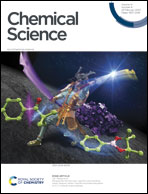Highly efficient Förster resonance energy transfer between an emissive tetraphenylethylene-based metal–organic cage and the encapsulated dye guest†
Abstract
The host–guest strategy presents an ideal way to achieve efficient Förster resonance energy transfer (FRET) by forcing close proximity between an energy donor and acceptor. Herein, by encapsulating the negatively charged acceptor dyes eosin Y (EY) or sulforhodamine 101 (SR101) in the cationic tetraphenylethene-based emissive cage-like host donor Zn-1, host–guest complexes were formed that exhibit highly efficient FRET. The energy transfer efficiency of Zn-1⊃EY reached 82.4%. To better verify the occurrence of the FRET process and make full use of the harvested energy, Zn-1⊃EY was successfully used as a photochemical catalyst for the dehalogenation of α-bromoacetophenone. Furthermore, the emission color of the host–guest system Zn-1⊃SR101 could be adjusted to exhibit bright white-light emission with the CIE coordinates (0.32, 0.33). This work details a promising approach to enhance the efficiency of the FRET process by the creation of a host–guest system between the cage-like host and dye acceptor, thus serving as a versatile platform for mimicking natural light-harvesting systems.



 Please wait while we load your content...
Please wait while we load your content...